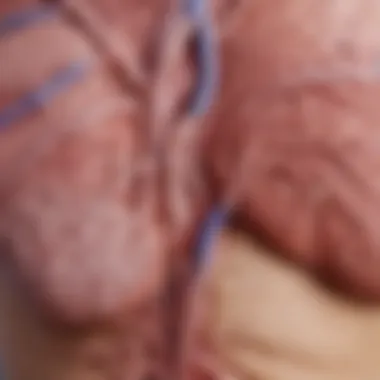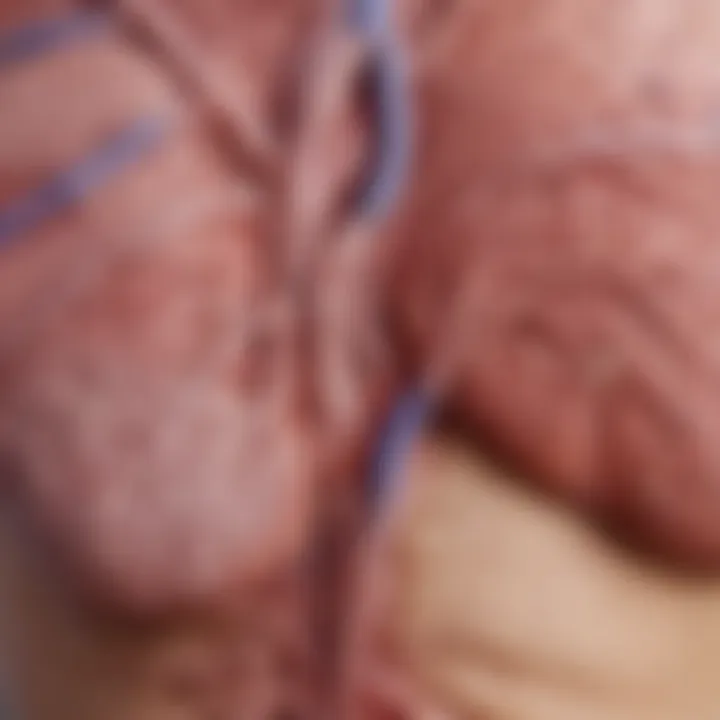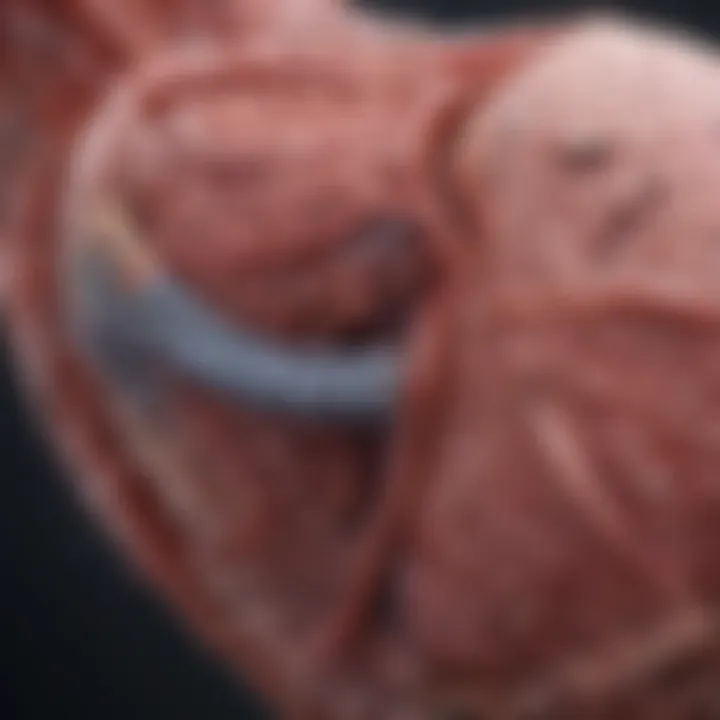Understanding Acute Exacerbation in Bronchiectasis


Intro
Bronchiectasis is often an overlooked condition, but it has profound effects on patients. It involves the abnormal dilation of the bronchi, which can lead to serious consequences like infections and breathing difficulties. When acute exacerbations occur, the situation becomes even more acute, making management and treatment crucial. These flare-ups can be triggered by various factors, from environmental changes to infections, and understanding them is essential for both patients and healthcare providers.
This article aims to shed light on bronchiectasis, especially in relation to acute exacerbation episodes. By comprehensively exploring the pathophysiology, triggers, diagnostic methods, and treatment strategies, we aim to empower readers with knowledge. The impact of this respiratory condition on a patient’s quality of life can't be overstated either, as it often dictates not just health but daily living.
Article Overview
Purpose of the Article
The purpose of this article is to unravel the complexities surrounding bronchiectasis, particularly the acute exacerbation phenomenon. We want to bridge the gap between existing knowledge and practical management techniques. Whether you're a student delving into respiratory diseases or a seasoned professional, understanding the nuances of this condition can enhance treatment approaches and improve patient outcomes.
Relevance to Multiple Disciplines
Bronchiectasis touches upon various facets of medicine including pulmonology, infectious diseases, and even public health. The crossover appeal of this topic extends to physicians, researchers, and educators alike. As healthcare practices evolve, a multidisciplinary approach becomes essential in comprehending and treating this condition effectively.
Research Background
Historical Context
Bronchiectasis has been recognized for many years, but the surge in understanding has only come recently. Historically, it was often misdiagnosed or undiagnosed due to insufficient medical knowledge and diagnostic tools. The rise of imaging techniques and microbiological advancements have changed how we view this disease. Before the advent of antibiotics, many patients faced grim outcomes, but now, there's hope and clarity about managing this complex condition.
Key Concepts and Definitions
To set the stage for our exploration of bronchiectasis, let’s clarify some key concepts:
- Bronchiectasis: A chronic condition defined by the permanent enlargement of parts of the airways of the lung.
- Acute Exacerbation: A sudden worsening of symptoms, often requiring urgent medical attention.
- Triggers: Factors that provoke exacerbations, including infections, allergens, and environmental pollutants.
Understanding these terms is vital as they lay the groundwork for deeper discussions about patient management and treatment strategies.
Preface to Bronchiectasis
Understanding bronchiectasis is vital for both patients and healthcare providers, as it lays the groundwork for recognizing the complexities of lung health. This condition involves a form of chronic obstructive pulmonary disease where the airways become abnormally dilated due to inflammation and infection. While it may not always be at the forefront of respiratory discussions, its presence can significantly impact an individual’s quality of life and lead to acute exacerbations.
Bronchiectasis can manifest for various reasons, and each instance may come with its unique set of challenges. Therefore, having a clear grasp on this condition is beneficial for identifying early symptoms, optimizing management strategies, and ultimately enhancing patient experience. This section will cover crucial aspects such as its definition, epidemiology, and risk factors, ensuring readers are well-equipped with knowledge.
Defining Bronchiectasis
Bronchiectasis refers to the abnormal and lasting enlargement of the bronchi, which are the large air passages from the trachea to the lungs. It arises when the airway walls become damaged, leading them to become thickened and unable to clear out mucus effectively. Consequently, this accumulation of mucus can facilitate lung infections, causing further damage and increasing symptoms such as cough and sputum production. By understanding this definition, readers can appreciate how critical early recognition and diagnosis are in managing the disease.
Epidemiology and Prevalence
In terms of epidemiology, bronchiectasis is surprisingly common yet often underdiagnosed. Studies indicate that it affects approximately 500,000 individuals in the United States alone. The prevalence varies with age, and it is witnessed more frequently in adults than in children.
The condition can arise from a variety of underlying causes including cystic fibrosis, previous lung infections, and autoimmune diseases, all influencing prevalence rates in diverse demographics. Since it can result from numerous origins, accurate surveillance is essential. Perhaps surprisingly, areas with higher rates of respiratory infections tend to see higher bronchiectasis rates, linking socioeconomic factors closely to public health.
Risk Factors and Causes
Several risk factors play a crucial role in determining who may develop bronchiectasis. Some of the common causes include:
- Infections: Recurrent or severe lung infections, especially in childhood, can take a toll.
- Cystic Fibrosis: This genetic disease is often cited as the most prevalent cause.
- Immune System Disorders: Conditions that weaken the immune system can make individuals susceptible.
In addition to these, environmental factors such as exposure to pollutants or tobacco smoke also contribute significantly. Understanding the link between these risk factors and bronchiectasis informs targeted prevention strategies and facilitates better patient education.
By delving into the fundamental aspects of bronchiectasis, readers are encouraged to look beyond initial symptoms, recognizing that this condition demands comprehensive management approaches tailored to individual patient needs.


Understanding Acute Exacerbations
Acute exacerbations of bronchiectasis represent a significant concern for both patients and healthcare providers. These episodes are not mere annoyances; they often signal escalating disease activity and have profound implications for an individual’s overall health, daily function, and emotional well-being. Grasping the full spectrum of these episodes is essential for developing effective treatment plans and promoting better outcomes.
Definition and Importance
In simple terms, an acute exacerbation in bronchiectasis refers to a sudden worsening of the patient’s respiratory symptoms, typically resulting from infection, inflammation, or other triggers. This deterioration can lead to increased cough, sputum production, and shortness of breath. Recognizing this definition is vital, as the management and intervention strategies hinge on timely detection of these exacerbations, which, left unchecked, may spiral into serious respiratory complications.
When we talk about the importance of understanding acute exacerbations, we cannot overlook their prevalence. Many individuals with bronchiectasis experience frequent exacerbations, often leading to repeated hospital visits and a decline in their quality of life. It’s a cycle that can be hard to break. By focusing on acute exacerbation events, healthcare providers can tailor interventions aimed at reducing the frequency and severity of these episodes, ultimately improving the patient’s day-to-day experience.
Moreover, evaluating the impact of these exacerbations extends beyond immediate health effects. Psychological ramifications often accompany the physical symptoms. Patients may become anxious about when the next exacerbation could occur or fear the implications of worsening disease. Understanding these episodes facilitates the development of holistic care approaches that not only treat the physical symptoms but also address the emotional and psychological factors at play.
Pathophysiological Mechanisms
The pathophysiological mechanisms underlying acute exacerbations of bronchiectasis are intricate and multifaceted. At the heart of these exacerbations often lies a cycle of inflammation, infection, and mucus obstruction. These elements work in harmony—albeit detrimentally—to perpetuate a detrimental state within the airways.
- Inflammation: Chronic inflammation is a hallmark of bronchiectasis. When exacerbations occur, this inflammation can intensify, creating an environment ripe for further complications. The airway becomes not only inflamed but also structurally altered over time, which impedes airflow.
- Infection: Bacterial infections frequently precipitate exacerbations. The presence of bacteria such as Pseudomonas aeruginosa can trigger a cascade of immune responses, leading to further mucus hypersecretion and airway blockage. It sets off a vicious cycle that is hard to escape from.
- Mucus Obstruction: The dysfunctional clearance of mucus plays a significant role in acute exacerbations. Inadequate mucus clearance leads to stagnant secretions and promotes the growth of bacteria. When the mucus thickens, it creates a breeding ground for pathogens, ultimately worsening overall respiratory function.
These mechanisms highlight the need for a thorough understanding of how exacerbations unfold in individuals with bronchiectasis. By unraveling these complex interactions, researchers and healthcare professionals can identify potential targets for interventions that might mitigate these exacerbation events.
"A careful understanding of the interplay between inflammation, infection, and mucus production can pave the way for more effective management strategies."
"A careful understanding of the interplay between inflammation, infection, and mucus production can pave the way for more effective management strategies."
Clinical Presentation
Understanding the clinical presentation of bronchiectasis, specifically during acute exacerbations, is paramount for both clinicians and affected individuals. This section provides insights into how symptoms manifest and how they can intertwine with other respiratory conditions. Recognizing these symptoms can significantly impact the timely management and treatment of the disease, ultimately enhancing patient outcomes.
Symptoms of Acute Exacerbation
Acute exacerbations of bronchiectasis are characterized by a sudden worsening of symptoms. These exacerbations can be frightening for patients and are often linked to increased morbidity. The most prominent symptoms may include:
- Persistent, increased cough: Often becomes more pronounced and may result in increased mucus production.
- Changes in sputum: Patients may notice a change in the color, volume, and smell of sputum, which can indicate an exacerbation.
- Worsening shortness of breath: While many patients already experience some level of dyspnea, exacerbations can lead to heightened difficulties in breathing.
- Fatigue: The effort of breathing and managing increased cough can lead to significant fatigue.
- Fever and malaise: Patients might also experience flu-like symptoms, which could lead to confusion in diagnosis.
Understanding these symptoms is crucial. They serve as key indicators for patients to seek medical advice. Early intervention during these times can prevent severe deterioration of health, and therefore, education about when to seek help is vital.
"Recognizing the early signs of acute exacerbations can mean the difference between managing symptoms at home and requiring hospitalization."
"Recognizing the early signs of acute exacerbations can mean the difference between managing symptoms at home and requiring hospitalization."
Differentiating from Other Respiratory Conditions
The ability to distinguish acute exacerbations of bronchiectasis from other respiratory conditions, like asthma or chronic obstructive pulmonary disease (COPD), is an art that demands keen clinical judgement. This differentiation is crucial, not only for correct diagnosis but also for effective treatment strategies. Some key points to consider include:
- Cough Characteristics: While cough is common in many respiratory diseases, the productive nature in bronchiectasis often sets it apart.
- Sputum Diversity: Changes in sputum color and consistency within bronchiectasis may differ from the characteristics seen in other conditions, such as asthma, which usually presents with minimal sputum production.
- Symptoms Timing: Acute exacerbations may occur in predictable patterns related to infections or environmental changes, while asthma may present with variable symptoms triggered by external factors.
- History of Condition: A comprehensive patient history showing chronic cough and recurrent infections can point towards bronchiectasis rather than acute asthma or COPD exacerbations.
In making these distinctions, physicians can tailor their management strategies effectively and potentially enhance treatment satisfaction. Accurate differentiation not only aims to treat but also to educate patients about their unique health conditions.
Diagnostic Approaches
Understanding the diagnostic approaches to bronchiectasis with acute exacerbation is crucial in managing this condition effectively. Accurate diagnosis greatly influences treatment decisions and can lead to better outcomes for patients. The complexity of this disease, coupled with its varying presentations, emphasizes the need for thorough, multi-faceted methodologies. This section delves into the three pivotal diagnostic techniques: imaging techniques, microbiological investigations, and pulmonary function tests, shedding light on their unique contributions to understanding bronchiectasis and managing acute exacerbations effectively.
Imaging Techniques
Imaging plays a foundational role in diagnosing bronchiectasis. High-resolution computed tomography (HRCT) scans stand at the forefront, providing detailed images that showcase the characteristic airway dilation. In patients with acute exacerbations, HRCT can reveal the extent of damage, mucus plugs, and possible complications like infections or structural changes in the lungs.
The proper use of imaging not only identifies existing bronchiectasis but also helps evaluate progression over time. Here are key benefits of employing imaging techniques:


- Early Detection: Identinating changes in airway structure can facilitate prompt intervention.
- Assessment of Severity: Quantifying extent of damage informs treatment strategies.
- Guiding Treatment: Imaging results can help direct further diagnostic processes, such as microbiological testing.
In doing so, imaging techniques assist not only in diagnosis but also in the ongoing monitoring of the disease.
Microbiological Investigations
Microbiological investigations offer insight into the infectious agents driving acute exacerbations in patients with bronchiectasis. A sample of sputum can reveal opportunistic pathogens that exacerbate symptoms, guiding targeted antibiotic therapy. Since infections play a pivotal role in exacerbations, identifying the underlying organisms is essential for effective management.
The role of microbiological testing can be broken down into several important aspects:
- Pathogen Identification: Recognizing specific bacteria can inform treatment options.
- Resistance Testing: Understanding antibiotic resistance patterns helps optimize therapy.
- Monitoring Treatment Response: Serial testing can reveal if the treatment is effective, leading to necessary adjustments.
Ultimately, microbiological investigations enhance the patient management process by supporting tailored therapeutic approaches, promoting better health outcomes.
Pulmonary Function Tests
Measuring lung function is another cornerstone in evaluating bronchiectasis, specifically during acute exacerbations. Pulmonary function tests, such as spirometry, provide quantifiable data about lung capability and airflow obstruction. Changes in these values during exacerbations can indicate the severity and urgency of medical intervention required.
The significance of pulmonary function tests lies in their ability to:
- Baseline Assessment: Establish a starting point for further comparison.
- Monitor Disease Progression: Analyze lung function over time for detailed insights.
- Evaluate Treatment Efficacy: Help assess how well interventions are improving lung capacity.
Proper interpretation of pulmonary function tests can reveal hidden challenges in managing bronchiectasis effectively.
Proper interpretation of pulmonary function tests can reveal hidden challenges in managing bronchiectasis effectively.
In summary, diagnostic approaches are never a one-size-fits-all solution. Each method contributes unique insights into bronchiectasis and acute exacerbations, helping to construct a more comprehensive understanding of the patient's condition. By employing imaging techniques, microbiological investigations, and pulmonary function tests, healthcare providers can ensure timely and effective management of this complex disease.
Management Strategies
The management of bronchiectasis, particularly during acute exacerbations, entails a multifaceted approach designed to alleviate symptoms, prevent further lung damage, and enhance overall patient well-being. Effective management strategies contribute not only to immediate recovery but also to long-term health improvements. Managing bronchiectasis properly can mitigate complications such as respiratory infections and declining lung function, which are critical, particularly in severe cases. In the context of recent developments and ongoing research, understanding these strategies is essential for healthcare providers and patients alike.
Pharmacological Interventions
Pharmacological interventions play a cornerstone role in managing bronchiectasis. These treatments often center around the use of antibiotics, bronchodilators, and anti-inflammatory medications. Here's a closer look at key components of these interventions:
- Antibiotics: During acute exacerbations, bacterial infections can worsen symptoms. Clinicians often initiate antibiotic therapy to tackle these infections head-on. The choice of antibiotic might depend on previous infection types and microbial cultures. Notably, tailored antibiotic therapy can significantly reduce exacerbation frequency.
- Bronchodilators: These medications work by relaxing and widening the air passages, making it easier for patients to breathe. For individuals experiencing wheezing or airflow obstruction, bronchodilators become a vital tool in the management kit.
- Anti-inflammatory Medications: Long-term control over inflammation in bronchiectasis may involve the use of corticosteroids. These can help reduce bronchial swelling, ultimately improving lung function and quality of life for some patients.
Incorporating these medications requires careful consideration of potential side effects and interactions, particularly in patients taking multiple drugs. Every decision should be patient-centered, often involving discussions about preferences and treatment expectations.
Non-Pharmacological Management
Beyond medications, non-pharmacological management strategies also hold significant sway in addressing bronchiectasis. These methods can enhance ventilation, improve overall quality of life, and potentially reduce the frequency of exacerbations. Key elements include:
- Airway Clearance Techniques: Practicing techniques such as chest physiotherapy can help clear excessive mucus from the lungs. This might involve manual chest percussion or devices designed to assist in mucous clearance. Effective clearance is crucial; stagnant mucus is often a breeding ground for bacteria.
- Physical Therapy: Tailored exercise programs can aid in improving lung capacity and overall physical fitness. Regular exercise may make it easier for patients to manage their condition and can contribute positively to mental health, too.
- Nutritional Support: Many patients with chronic lung conditions face Challenges related to nutrition. A well-balanced diet can bolster immune function and overall health. Nutritional specialists can guide appropriate dietary changes tailored to individual needs.
- Patient Education: Educating patients about their condition, self-management techniques, and recognizing exacerbation triggers empowers them to play an active role in their health. Knowledge is a potent tool in managing bronchiectasis.
"Proper management of bronchiectasis can transform a patient's life. It becomes a collaborative process, where both healthcare providers and patients navigate towards better respiratory health."
"Proper management of bronchiectasis can transform a patient's life. It becomes a collaborative process, where both healthcare providers and patients navigate towards better respiratory health."
In summary, management strategies for bronchiectasis and acute exacerbations go beyond simple medication regimens. These include an integrated approach of pharmacological and non-pharmacological interventions, tailored to individual patient needs, which help improve health outcomes and quality of life.
Impact on Quality of Life
The impact of bronchiectasis on a patient's quality of life is often profound and multifaceted. As individuals grapple with the symptoms and challenges associated with this condition, it becomes clear that understanding these impacts is crucial not only for medical professionals but for patients, families, and caregivers as well. The quality of life encompasses both physical health and mental well-being, and clear connections exist between the severity of bronchiectasis and daily functioning.
Acute exacerbations act as disruptive forces in the lives of those affected. These episodes can lead to increased difficulty in performing routine activities and an overall decrease in well-being. A patient might find themselves stuck at home during flare-ups, missing work or social engagements, creating feelings of isolation and frustration. Moreover, the unpredictability of these exacerbations induces a lingering anxiety that affects not only the patients but also their families. A heightened concern about future episodes can lead to avoidance of physical activities or social situations, further entrenching a cycle of despair.


Psychosocial Effects
The psychosocial ramifications of bronchiectasis are significant. Many patients experience anxiety and depression as they face chronic illness. The psychological toll can be quite heavy, bringing feelings of helplessness and sometimes hopelessness. Patients often feel they are on a treadmill, as managing their symptoms feels like a never-ending struggle.
- Social Isolation: Friends and family may not fully grasp the complexities of living with bronchiectasis. Misunderstandings about the illness can lead to social withdrawal, making patients feel like they're battling their condition alone.
- Impact on Relationships: Families may struggle to understand the limitations faced by their loved ones with bronchiectasis, leading to tension or guilt. Even the most well-meaning friends may sometimes engage in activities that leave patients feeling unable to keep up, creating feelings of inadequacy.
- Mental Health Concerns: A significant correlation exists between chronic respiratory conditions and mental health disorders. Patients may face not only the tangible symptoms of their disease but also mood swings, irritability, and reduced cognitive function, all of which further complicate the management of their condition.
"Quality of life can often be more impacted by the manageability of symptoms than the disease itself. The emotional and psychological dimensions need equal attention as we treat physical ailments."
"Quality of life can often be more impacted by the manageability of symptoms than the disease itself. The emotional and psychological dimensions need equal attention as we treat physical ailments."
Economic Burden of Illness
Economic factors also play a critical role in the quality of life for bronchiectasis patients. The direct and indirect costs associated with managing acute exacerbations can be extensive.
- Direct Medical Costs: These include hospitalizations, medication expenses, routine check-ups, and possibly the need for specialized therapies. Resources can dwindle quickly during acute worsening of the condition. This burden is not limited to patients alone; families often find themselves facing increased caregiving costs and sometimes having to forgo work to provide needed support.
- Indirect Costs: Patients may face lost wages due to absence from work, as frequent exacerbations can limit their ability to maintain a consistent employment. The emotional distress associated with fluctuating health can also reduce productivity in both personal and professional spheres.
- Insurance and Healthcare Access: For some, the healthcare system presents another roadblock. Those without adequate insurance may shy away from seeking necessary care, leading to even more severe health outcomes and, ironically, higher long-term costs due to unmanaged symptoms.
Complications Associated with Bronchiectasis
Bronchiectasis is not merely a static condition; it sets the stage for various complications that can deeply influence a patient's prognosis and quality of life. Understanding these complications is essential, as they provide insight into the disease's progression and underscore the importance of comprehensive management strategies.
Respiratory Failure
One of the most critical complications linked with bronchiectasis is respiratory failure. This occurs when the lungs can't maintain adequate gas exchange, leading to oxygen deprivation or an accumulation of carbon dioxide in the bloodstream. Factors such as recurrent infections, destruction of lung tissue, and impaired airway clearance contribute to this alarming situation.
Patients experiencing respiratory failure may present with symptoms like shortness of breath, cyanosis, or confusion, which necessitate immediate medical attention. In severe cases, it might lead to the need for mechanical ventilation, posing not just a physical challenge but also emotional and financial burdens for patients and families alike.
Management of respiratory failure involves a multifaceted approach. Oxygen therapy may be necessary to help maintain adequate oxygen levels. Additionally, more invasive interventions such as bronchoscopy may be needed to clear obstructed airways, especially during acute exacerbations. Preventative measures through regular monitoring and comprehensive care, including vaccinations for influenza and pneumococcus, can significantly reduce the risk of respiratory failure in bronchiectasis patients.
Hemoptysis
Another notable complication is hemoptysis, the coughing up of blood or blood-stained sputum. While it may range from slight blood-tinged sputum to large volumes of blood, hemoptysis is often alarming for both the patient and healthcare providers. It can indicate underlying issues like infection, inflammation, or the erosion of blood vessels in the airways.
Why is Hemoptysis a Concern?
- Indicator of Disease Progression: Hemoptysis often correlates with worsening disease, indicating that the bronchiectasis may be advancing.
- Potential for Serious Events: In rare cases, severe hemoptysis can lead to a complete obstruction of the airway, which can be a life-threatening situation.
- Psychological Impact: Experiencing hemoptysis can instill fear and anxiety, negatively affecting a patient's mental health and compliance with treatment.
Management strategies for hemoptysis include identifying the underlying cause, which might involve imaging studies such as a CT scan of the chest. Treatment depends on the severity and causes; options include bronchial artery embolization in more severe cases.
"Managing complications like respiratory failure and hemoptysis is pivotal in improving the overall outcomes for bronchiectasis patients, shining a spotlight on the necessity for ongoing research and better treatment modalities."
"Managing complications like respiratory failure and hemoptysis is pivotal in improving the overall outcomes for bronchiectasis patients, shining a spotlight on the necessity for ongoing research and better treatment modalities."
Research and Future Directions
Research in bronchiectasis and its acute exacerbations remains a pivotal area for advancing patient care and improving outcomes. With growing awareness of this condition in the medical field, investigators are increasingly focusing on factors that influence the disease's progression and management. Understanding these directions not only sheds light on current challenges but also aids in implementing new strategies that may significantly enhance patient quality of life.
Emerging Therapies
One of the most promising aspects of research in bronchiectasis is the development of emerging therapies. These innovations offer new hope for patients suffering from chronic symptoms and recurrent exacerbations. Some of the notable developments in therapy include:
- Biologics: Targeting specific pathways in the immune response, biologics are beginning to show potential in reducing exacerbations and improving lung function in patients with bronchiectasis associated with conditions like asthma.
- Nanotechnology: Utilizing nanoparticles for drug delivery can enhance treatment efficacy. By concentrating medications right where they're needed in the lungs, these approaches could lead to fewer side effects and better outcomes.
- Gene Therapy: Research into gene therapy is advancing slowly but surely. It holds promise, particularly for patients with hereditary forms of bronchiectasis, as it seeks to address the underlying genetic issues.
Comprehensively analyzing such therapies allows for a more personalized approach to treatment, tailoring interventions to the specific triggers of each individual's condition.
Ongoing Clinical Trials
The landscape of ongoing clinical trials is crucial for understanding how new therapies will ultimately shape bronchiectasis management. For researchers and practitioners alike, keeping abreast of these trials is vital for several reasons:
- They provide insights into effective management strategies that might soon become standard practice.
- Participation in trials offers patients access to cutting-edge treatments not yet available in the market, thereby contributing directly to the body of research in bronchi-related diseases.
Recent trials focus on:
- Antibiotic resistance: With the rising issue of antibiotic-resistant infections, ongoing studies aim to evaluate alternative antibiotics or treatment regimens that could mitigate this problem.
- Pulmonary rehabilitation programs: Striving to enhance function and wellbeing, these programs are continually being assessed for their long-term benefits and applicability in broader patient populations.
- Quality of life metrics: Trials also consider patient-reported outcomes, emphasizing the importance of not just surviving but thriving.



